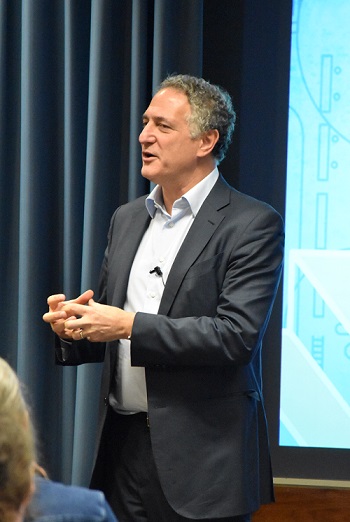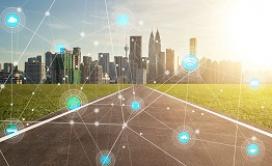Reimagining Transportation from the Internet Up with Dan Doctoroff
The biggest revolutions over the past two centuries in urban environments have happened where technologies meet city life, according to Daniel Doctoroff, chairman and CEO of Sidewalk Labs, who spoke as part of Volpe’s Future of Transportation series.
“For better or worse: the steam engine, the electric grid, and the automobile,” Doctoroff said. “Now, I believe, we are on the verge of what I like to call the fourth technological revolution in cities.”
That revolution is part and parcel of the digital age—and it’s happening where vehicle automation and the Internet converge on city streetscapes. Cities and citizens are still determining how this revolution will play out and change urban life.
Watch video highlights from Daniel Doctoroff's talk at Volpe.
The Internet as a Foundation for Urban Design
Imagine a city that is ubiquitously connected to the Internet, Doctoroff said. The Internet is the starting point for driving technological change in this city, and the city itself becomes a platform to gather a wealth of intelligence. Data is harnessed to improve urban life, with infrastructure and policy decisions guided by previously unseen amounts of information on road quality, cycling patterns, emissions, and more.
“When you imagine a city from the Internet up, you get a place that is personalized for our needs and desires,” Doctoroff said. “A place that is adaptable, constantly evolving with changing demands, technologies, and tastes. A place that feels like a city, but functions like a community.”
Cities that provide transportation access that is harmonious and multimodal—and not dominated by automated vehicles—will be built upon four pillars, Doctoroff said.
Four Pillars for Building from the Internet Up
The first pillar is personalized transportation. In a city built from the Internet up, citizens enter a destination into a smartphone app, then find, reserve, and pay for a parking spot—all before leaving the house. There’s no circling for parking, and there is less congestion and pollution. Travelers might also find cheaper or faster options by virtually hailing a taxi or taking public transportation.
 “That means cleaner, more equitable cities,” Doctoroff said. “The result is a much more personalized mobility experience.”
“That means cleaner, more equitable cities,” Doctoroff said. “The result is a much more personalized mobility experience.”
The second pillar is adaptability. With real-time data collected through smartphones or other technology, transit systems are reconfigured based on precise pictures of fluctuating travel demand.
“That doesn’t mean cities would magically have the money to run buses everywhere,” Doctoroff said. “But you would know with much more certainty whether or not you were meeting the challenge of transport equity and be able to deploy bus service as efficiently is possible to meet local goals.”
The third pillar is about new, granular data providing better performance measures. Today, cities measure transit quality by how often a vehicle operates, and how far citizens are from transit stops. But there is little data on whether people get to their destinations on time, or the percentage of jobs accessible by transit, Doctoroff said.
The fourth and final pillar is about improving transparency and accountability. Traffic laws can be enforced with objectivity. Toll booths become completely wireless, and people operating toll booths are transitioned to more critical jobs, such as security, Doctoroff said. As the urban environment becomes more instrumented, protecting privacy also becomes more paramount.
“The future is not just for technologists to reimagine, because imagination on its own doesn’t change the world,” Doctoroff said. “It’s the policy makers who can bring these ideas from the digital cloud to the actual curb that will determine what shape our future cities ultimately take.”

